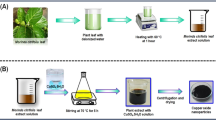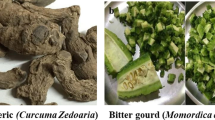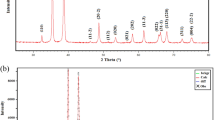Abstract
Metal oxide nanoparticles have numerous applications in the food processing, agriculture, and medical field. The green way synthesis of metal oxide nanoparticles using leaf extracts has gained great interest because of cost effective, rapid, simple, and eco-friendly approach. In this research work, we report the synthesis of copper oxide nanoparticles (CuO NPs) using Eupatorium odoratum and Acanthospermum hispidum leaf extracts at room temperature (27 °C). Further, the synthesized CuO NPs were characterized using UV-visible spectroscopy, Fourier transform infrared spectroscopy, X-ray diffraction, scanning electron microscopy with energy dispersive atomic X-ray spectroscopy, and transmission electron microscopy technique. The zone of inhibition against Staphylococcus aureus, Bacillus cereus, and Escherichia coli was found to be 19 mm, 12 mm, and 15 mm for CuO NPs synthesized using Eupatorium odoratum extract and 13 mm, 10 mm, and 20 mm for CuO NPs synthesized using Acanthospermum hispidum extract. The green synthesized CuO NPs are an effective candidate which plausibly utilized in the biomedical field.

Graphical Abstract






Similar content being viewed by others
References
Rajeshkumar, S., Kannan, C., & Annadurai, G. (2012). Synthesis and characterization of antimicrobial silver nanoparticles using marine brown seaweed Padina tetrastromatica. Drug Invention Today, 4, 511–513.
Ramkumar, V. S., Pugazhendhi, A., Gopalakrishnan, K., Sivagurunathan, P., Saratale, G. D., Dung, T. N. B., & Kannapiran, E. (2017). Biofabrication and characterization of silver nanoparticles using aqueous extract of seaweed Enteromorpha compressa and its biomedical properties. Biotechnology Reports, 14(1–7).
Phongtongpasuk, S., Poadang, S., & Yongvanich, N. (2016). Environmental-friendly method for synthesis of silver nanoparticles from Dragon fruit peel extract and their antibacterial activities. Energy Procedia, 89, 239–247.
Latha, N., & Gowri, M. (2014). Bio synthesis and characterisation of Fe3o4 nanoparticles using Caricaya papaya leaves extract. International Journal of Science and Research, 3, 1551–1556.
Marchiol, L., Mattiello, A., Pošćić, F., Giordano, C., & Musetti, R. (2014). In vivo synthesis of nanomaterials in plants: Location of silver nanoparticles and plant metabolism. Nanoscale Research Letters, 9, 101.
Siddiqi, K. S., & Husen, A. (2016). Fabrication of metal nanoparticles from fungi and metal salts: Scope and application. Nanoscale Research Letters, 11, 98.
Yasmin, A., Ramesh, K., & Rajeshkumar, S. (2014). Optimization and stabilization of gold nanoparticles by using herbal plant extract with microwave heating. Nano Convergence, 1, 12.
Banerjee, P., Satapathy, M., Mukhopahayay, A., & Das, P. (2014). Leaf extract mediated green synthesis of silver nanoparticles from widely available Indian plants: Synthesis, characterization, antimicrobial property and toxicity analysis. Bioresources and Bioprocessing, 1, 3.
Acharyulu, N. P. S., Dubey, R. S., Swaminadham, V., Pratap, K., Kalyani, R. L., & Pammi, S. V. N. (2014). Green synthesis of CuO nanoparticles using Phyllanthus amarus leaf extract and their antibacterial activity against multidrug resistance bacteria. International Journal of Engineering Research and Technology, 3, 639–641.
Sahooli, M., Sabbaghi, S., & Saboori, R. (2012). Synthesis and characterization of mono sized CuO nanoparticles. Materials Letters, 81, 169–172.
Soltanianfard, M. J., & Firoozadeh, A. (2016). Synthesis and characterization of copper(II)-oxide nanoparticles from two Cu(II) coordination polymers. Journal of Sciences, Islamic Republic of Iran, 27, 113–117.
Radhakrishnan, A. A., & Beena, B. B. (2014). Structural and optical absorption analysis of CuO nanoparticles. Indian Journal of Advances in Chemical science, 2, 158–161.
Dar, M. A., Kim, Y. S., Kim, W. B., Sohn, J. M., & Shin, H. S. (2008). Structural and magnetic properties of CuO nanoneedles synthesized by hydrothermal method. Applied Surface Science, 254, 7477–7481.
Dang, T. M. D., Le, T. T. T., Fribourg-Blanc, E., & Dang, M. C. (2011). Synthesis and optical properties of copper nanoparticles prepared by a chemical reduction method. Advances in Natural Sciences: Nanoscience and Nanotechnology, 2, 015009.
Sundaramurthy, N., & Parthiban, C. (2015). Biosynthesis of copper oxide nanoparticles using Pyrus pyrifolia leaf extract and evolve the catalytic activity. International Research Journal of Engineering and Technology, 2, 332–338.
Dastjerdi, R., & Montazer, M. (2010). A review on the application of inorganic nano-structured materials in the modification of textiles: Focus on anti-microbial properties. Colloids and Surfaces B: Biointerfaces, 79, 5–18.
Udayabhanu, Nethravathi, P. C., Pavan Kumar, M. A., Suresh, D., Lingaraju, K., Rajanaika, H., Nagabhushana, H., & Sharma, S. C. (2015). Tinospora cordifolia mediated facile green synthesis of cupric oxide nanoparticles and their photocatalytic, antioxidant and antibacterial properties. Materials Science in Semiconductor Processing, 33, 81–88.
Prabhu, Y. T., Venkateswara Rao, K., Sesha Sai, V., & Pavani, T. (2017). A facile biosynthesis of copper nanoparticles: A micro-structural and antibacterial activity investigation. Journal of Saudi Chemical Society, 21, 180–185.
Naika, H. R., Lingaraju, K., Manjunath, K., Kumar, D., Nagaraju, G., Suresh, D., & Nagabhushana, H. (2015). Green synthesis of CuO nanoparticles using Gloriosa superba L. extract and their antibacterial activity. Journal of Taibah University for Science, 9, 7–12.
Chung, I., Abdul Rahuman, A., Marimuthu, S., Vishnu Kirthi, A., Anbarasan, K., Padmini, P., & Rajakumar, G. (2017). Green synthesis of copper nanoparticles using Eclipta prostrata leaves extract and their antioxidant and cytotoxic activities. Experimental and Therapeutic Medicine, 14, 18–24.
Jayakumarai, G., Gokulpriya, C., Sudhapriya, R., Sharmila, G., & Muthukumaran, C. (2015). Phytofabrication and characterization of monodisperse copper oxide nanoparticles using Albizia lebbeck leaf extract. Applied Nanoscience, 5, 1017–1021.
Sharma, J. K., Akhtar, M. S., Ameen, S., Srivastava, P., & Singh, G. (2015). Green synthesis of CuO nanoparticles with leaf extract of Calotropis gigantea and its dye-sensitized solar cells applications. Journal of Alloys and Compounds, 632, 321–325.
Sharma, B. K., Shah, D. V., & Roy, D. R. (2018). Green synthesis of CuO nanoparticles using Azadirachta indica and its antibacterial activity for medicinal applications. Materials Research Express, 5, 095033.
Vijay Kumar, P. P. N., Shameem, U., Kollu, P., Kalyani, R. L., & Pammi, S. V. N. (2015). Green synthesis of copper oxide nanoparticles using Aloe vera leaf extract and its antibacterial activity against fish bacterial pathogens. BioNanoScience, 5, 135–139.
Caroling, G., Vinodhini, E., Ranjitham, A. M., & Shanthi, P. (2015). Biosynthesis of copper nanoparticles using aqueous Phyllanthus embilica (Gooseberry) extract-characterization and study of antimicrobial effects. International Journal of Nanomaterials and Chemistry, 1, 53–63.
Sivaraj, R., Rahman, P. K. S. M., Rajiv, P., Salam, H. A., & Venckatesh, R. (2014). Biogenic copper oxide nanoparticles synthesis using Tabernaemontana divaricate leaf extract and its antibacterial activity against urinary tract pathogen. Spectrochimica Acta Part A: Molecular and Biomolecular Spectroscopy, 133, 178–181.
Sankar, R., Maheswari, R., Karthik, S., Shivashangari, K. S., & Ravikumar, V. (2014). Anticancer activity of Ficus religiosa engineered copper oxide nanoparticles. Materials Science and Engineering: C, 44, 234–239.
Pradeepkumar, P., Govindaraj, D., Jeyaraj, M., Munusamy, M. A., & Rajan, M. (2017). Assembling of multifunctional latex-based hybrid nanocarriers from Calotropis gigantea for sustained (doxorubicin) DOX releases. Biomedicine & Pharmacotherapy, 87, 461–470.
Jeyaraj, M., Amarnath Praphakar, R., Rajendran, C., Ponnamma, D., Sadasivuni, K. K., Munusamy, M. A., & Rajan, M. (2016). Surface functionalization of natural lignin isolated from Aloe barbadensis Miller biomass by atom transfer radical polymerisation for enhanced anticancer efficacy. RSC Advances, 6, 51310–51319.
Govintharaj, D., & Rajan, M. (2016). Synthesis and spectral characterization of novel nano-hydroxyapatite from Moringa oleifera Leaf. Materials Today: Proceedings, 3, 2394–2398.
Harun, F. B., Jamalullail, S. M. S. S., Yin, K. B., Othman, Z., Tilwari, A., & Balaram, P. (2012). Autophagic cell death is induced by acetone and ethyl acetate extracts from Eupatorium odoratum in vitro: Effects on MCF-7 and vero cell lines. The Scientific World Journal, 2012, 1–9.
Bhargava, D., Sanjay, K., Jagadish, N. S., Bikash, S., & Chiranjit, M. (2011). Screening of antigonorrhoeal activity of some medicinal plants in Nepal. International Journal of Pharma and Bioscience, 2, 203–212.
Roy, H., Chakraborty, A., Bhanja, S., Nayak, B. S., Mishra, S. R., & Ellaiah, P. (2010). Preliminary phytochemical investigation and anthelmintic activity of Acanthospermum hispidum DC. Journal of Pharmaceutical Science and Technology, 2, 217–221.
Chakraborty, A. K., Gaikwad, A. V., & Singh, K. B. (2012). Phytopharmacological review on Acanthospermum hispidum. Journal of Applied Pharmaceutical Science, 02, 144–148.
Ahmed, S., Saifullah, Ahmad, M., Swami, B. L., & Ikram, S. (2016). Green synthesis of silver nanoparticles using Azadirachta indica aqueous leaf extract. Journal of Radiation Research and Applied Science, 9, 1–7.
Tchakam, P. D., Lunga, P. K., Kowa, T. K., Lonfouo, A. H. N., Wabo, H. K., Tapondjou, L. A., Tane, P., & Kuiate, J. R. (2012). Antimicrobial and antioxidant activities of the extracts and compounds from the leaves of Psorospermum aurantiacum Engl. and Hypericum lanceolatum Lam. BMC Complementary and Alternative Medicine, 12, 136.
Rayapa Reddy, K. (2017). Green synthesis, morphological and optical studies of CuO nanoparticles. Journal of Molecular Structure, 1150, 553–557.
Caroling, G., Priyadharshini, M. N., Vinodhini, E., Ranjitham, A. M., & Shanthi, P. (2015). Biosynthesis of copper nanoparticles using aqueous guava extract-characterisation and study of antibacterial effects. International Journal of Pharma and Bio Sciences, 5, 25–43.
Kelly, K. L., Coronado, E., Zhao, L. L., & Schatz, G. C. (2003). The optical properties of metal nanoparticles: The influence of size, shape, and dielectric environment. Journal of Physical Chemistry B, 107, 668–677.
Rao, K. J., & Paria, S. (2013). Green synthesis of silver nanoparticles from aqueous Aegle marmelos leaf extract. Materials Research Bulletin, 48, 628–634.41.
Shi, L. B., Tang, P. F., Zhang, W., Zhao, Y. P., Zhang, L. C., & Zhang, H. (2017). Green synthesis of CuO nanoparticles using Cassia auriculata leaf extract and in vitro evaluation of their biocompatibility with rheumatoid arthritis macrophages (RAW 264.7). Tropical Journal of Pharmaceutical Research, 16, 185–192.
Mariselvam, R., Ranjitsingh, A. J. A., Padmalatha, C., & Selvakumar, P. M. (2014). Green synthesis of copper quantum dots using Rubia cardifolia plant root extracts and its antibacterial properties. Journal of Academia and Industrial Research, 3, 191–194.
Amarnath Praphakar, R., Jeyaraj, M., Ahmed, M., & Rajan, M. (2018). Silver nanoparticle functionalized CS-g-(CA-MA-PZA) carrier for sustainable anti-tuberculosis drug delivery. International Journal of Biological Macromolecules, 118, 1627–1638.
Abboud, Y., Saffaj, T., Chagraoui, A., Bouari, A. E., Brouzi, K., Tanane, O., & Ihssane, B. (2014). Biosynthesis, characterization and antimicrobial activity of copper oxide nanoparticles produced using brown alga extract (Bifurcariabifurcata). Applied Nanoscience, 4, 571–576.
Azam, A., Ahmed, A. S., Oves, M., Khan, M. S., & Memic, A. (2012). Size-dependent antimicrobial properties of CuO nanoparticles against gram-positive and -negative bacterial strains. International Journal of Nanomedicine, 7, 3527–3535.
Sharmila, G., Thirumarimurugan, M., & Sivakumar, V. M. (2016). Optical, catalytic and antibacterial properties of phytofabricated CuO nanoparticles using Tecoma castanifolia leaf extract. Optik - International Journal for Light and Electron Optics, 127, 7822–7828.
Author information
Authors and Affiliations
Corresponding author
Ethics declarations
Conflict of Interest
None.
Research Involving Humans and Animals Statement
None.
Informed Consent
None.
Funding Statement
None.
Additional information
Publisher’s Note
Springer Nature remains neutral with regard to jurisdictional claims in published maps and institutional affiliations.
Rights and permissions
About this article
Cite this article
Gowri, M., Latha, N. & Rajan, M. Copper Oxide Nanoparticles Synthesized Using Eupatorium odoratum, Acanthospermum hispidum Leaf Extracts, and Its Antibacterial Effects Against Pathogens: a Comparative Study. BioNanoSci. 9, 545–552 (2019). https://doi.org/10.1007/s12668-019-00655-7
Published:
Issue Date:
DOI: https://doi.org/10.1007/s12668-019-00655-7




